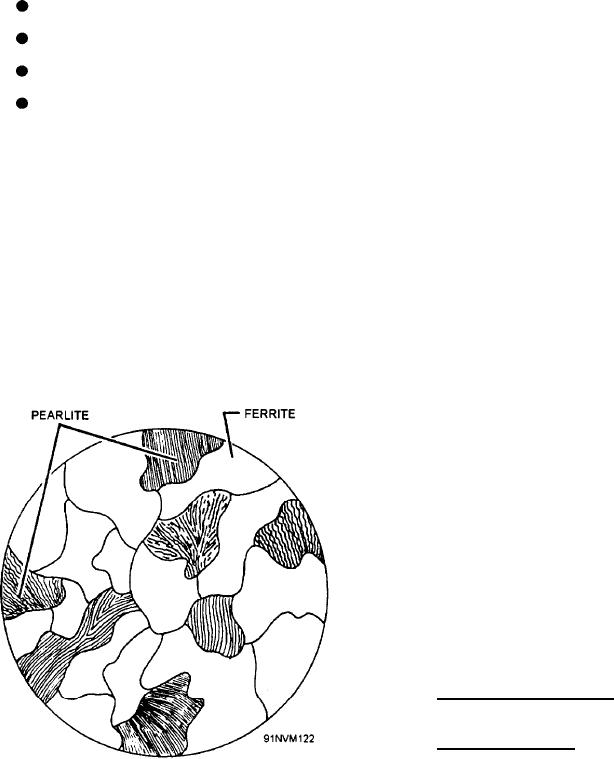
This combination contains no free crystals of
ELASTICITY
ferrite; instead, it consists of crystals of pearlite
As previously noted, a deformation or change of
surrounded by cementite at the grain boundaries.
shape (strain) occurs when a material is subjected to
external forces that cause stresses in the material. The
ability of a material to return to its original size and
PROPERTIES OF METAL
shape after strain is the property known as elasticity.
All materials are elastic to some extent. It may
A PHYSICAL PROPERTY is a characteristic of a
surprise you to learn that a piece of steel is more elastic
metal that may be observed or measured. The physical
than a rubber band. The rubber band stretches more
properties of steel are affected by the following:
than the steel since it is more easily strained, but the
steel returns more nearly to its original shape and size
Carbon content
and is, therefore, more truly elastic. Glass is also more
elastic than rubber.
Addition of various alloying metals
The greatest stress that a material is capable of
withstanding without taking a permanent set (that is
Heat treatment
without becoming permanently deformed) is known
as the ELASTIC LIMIT. Below the elastic limit, the
The particular properties that we require of any
amount of strain is directly proportional to the amount
metal or alloy depend upon the use we will make of
of stress and, therefore, to the amount of externally
the material. For example, an anchor chain must have
applied force. Above the elastic limit, however, the
the property of toughness; a boiler tube must have high
amount of deformation that results from an increase in
tensile strength, the ability to conduct heat, and the
load is way out of proportion to the increase in load.
ability to resist deformation or creep at high
temperatures; an electric wire must be able to conduct
Strain may be axial, angular, or both, depending
electricity; a knife blade must have the property of
upon the nature of the applied load and the stresses
hardness; a spring must be elastic; a saltwater piping
that are developed within the material to withstand the
system must resist corrosion; and a piece of metal that
applied load. When the elastic limit is exceeded
is to be drawn out into a wire must possess the property
through the application of an axial load, the material
known as ductility. The following sections deal with
w i l l be permanently deformed either by
some important properties of metals and alloys.
ELONGATION or by COMPRESSION. When the
applied load is not axial (as in shear and torsion), the
resulting strain is angular and, if permanent
deformation results, the deformation is also angular.
As noted before, the amount of strain is propor-
tional to the amount of stress up to (or almost up to) the
elastic limit. The ratio of stress to strain is, therefore, a
constant for each material. This constant, which is
called the MODULUS OF ELASTICITY, is obtained
by dividing the stress by the strain, which is the elonga-
tion caused by that stress. For example, suppose that a
certain material is so loaded that the internal stress
developed in tension is 30,000 psi and that with this
stress the material elongates or is strained 0.0015 inch
per inch. The modulus of elasticity (E) of this material
is
Stress (psi)
E=
Elongation (inch per inch)
30,000 psi
= 0.0015 inch per inch
Figure 6-8.--Typical structure of steel containing less than
= 20,000,000 psi
0.85 percent carbon.
6-7

